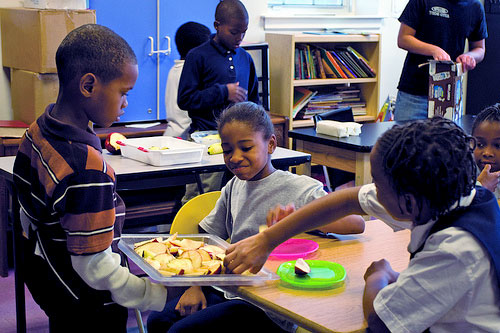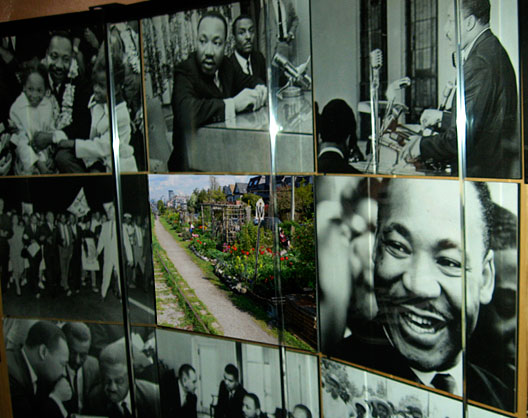Note: This is a version of a speech I delivered in 2009 at Duke University’s Sara P. Duke Garden at the invitation of the student group Farmhand, but it’s absolutely still relevant today.
I want to congratulate the members of Farmhand for their brilliant idea of celebrating Martin Luther King Jr.’s legacy at a garden. And not just any garden, but a culinary garden, one whose produce not only delights the eye but actually feeds people; and not just a culinary garden, but a community garden, one that brings people together across race, class, and age lines to grow things together.
I doubt that Dr. King found much time to hang out among the flower buds, but I don’t doubt he would have approved of the practice of community gardening. And of course, as an African American from the Deep South, he was exposed to the tradition of home gardening and smallholder farming, and he saw how cooks, both white and black, built a food culture out of the resulting bounty of collard greens, butter beans, okra, and other flavorful and highly nutritious foods.
Since King’s time, “soul food” has undergone a process of industrialization; it is now demonized as unhealthy, a view based more on the “Southern fried” stereotypes than the multitude of ways cooks in the South actually prepare these foods. (There’s a new movement afoot led by eco-chef Bryant Terry and others to take soul food back to its roots.)
Meanwhile, the brutal economics of farming in the 20th century, along with a heavy dose of official racism at the USDA, all but wiped out a vibrant tradition of black farming in the South. And as African Americans emigrated from towns to cities, the practice of keeping a kitchen garden waned — and, like other Americans, blacks grew more and more reliant on the budding convenience-food industry.
None of this gets much play in the mainstream commentaries on King’s legacy that come out around his birthday. In typical accounts, a narrative of triumph often holds sway. King went from obscure preacher to civil rights leader and adviser to presidents, in the process helping overturn hundreds of years of racist ideology in the United States. King’s “dream” reached its culmination in the Voting Rights Act and the integration of lunch counters and schools.
Yet when you read biographies of King — I’m thinking of Taylor Branch’s magisterial trilogy — you find that King himself rarely saw the drama of his life as a triumph. He lived in a constant state of doubt and uncertainty about what to do next; he knew many defeats; he constantly had to fear for his life; and in the last years, he grew increasingly pessimistic about the class divide that he feared would only reinforce the racial divide. That’s what led him to Memphis in 1968 to lend support to an effort to organize black garbage workers. And then, of course, he got shot.
King left behind a magnificent legacy, but we don’t do his memory justice unless we acknowledge that his work was profoundly unfinished. The class divide he feared has persisted and, in fact, grown more powerful. Perhaps most insidiously, that divide has entrenched itself in our food system.
King died at the end of the great post-World War II economic boom, a period when real median wages grew robustly. Since then, wages have stagnated. According to University of Massachusetts economist Robert Pollin’s Contours of Descent, the median hourly wage (in 2000 dollars) peaked at $15.73 in 1973 and by 2000 stood at $14.15. Since then, the median wage has flatlined. With wages stuck in neutral, growth in household incomes since King’s time has come from more family members entering the workforce, leaving less time for cooking at home.
Under these austere conditions, African-American families have not come close to closing the wage gap with their white counterparts. In an article in The American Prospect, the economist William Rogers shows that black families still bring home just 72 cents for every dollar earned by white families.
In the decades since King’s death, the food system underwent a transformation. Starting in the early 1970s, the federal government began to pursue a policy of cheap grain, tweaking farm policy to push farmers to maximize production of animal-feed crops like corn and soy. The food industry leveraged the bounty of corn and soy to intensify meat production, giving rise to the concentrated-animal feeding operation (CAFO). But even an explosion in CAFOs couldn’t absorb all the cheap corn that farmers were churning out; and one company, Archer Daniels Midland, figured out how to turn government-subsidized corn into a dirt-cheap but highly profitable sweetener. These developments led to sharp declines in food prices compared to incomes — putting a bounty of low-quality meat and subsidized soft drinks and other junk food within nearly everyone’s reach.
Of course, these trends coincided with an emerging backlash against industrial food — a movement toward farmers markets, natural-foods supermarkets like Whole Foods, and other sources of fresh, unprocessed fare. But here, too, African Americans were largely marginalized. In cities across the country, “food deserts” persist: areas where almost no fresh food (much less local or organic fare) is available, forcing residents to either travel great distances to supermarkets or rely on overpriced processed fare from corner stores.
It shouldn’t come as a surprise that African Americans face significantly higher rates [PDF] of diet-related diseases such as Type II diabetes. And these maladies tend to fall harder on blacks than whites. One recent study found that black children with diabetes are twice as likely to die from the disease as white children. Another study found that the black diabetes rate continues to rise faster than the rate for whites — and that blacks tend to be stricken with the disease at younger ages.
In our society, there’s a strong focus on individual solutions to the problems I’m laying out here. Commentators focus on personal choice; we are urged to “transform our food system one bite at a time” by exercising our consumer power to buy fresh, local, sustainably raised food.
But the choices we have are limited by structural forces. Yes, people need to take responsibility for their food choices, but if we’re really going to throw off the dead hand of industrial food, we need to transform the conditions under which people make their food choices.
In one of his most famous statements, King declared that “no one is free until everyone is free.” Our food system drives home that maxim. For 30 years, a combination of virtuous personal consumption choices and gritty organizing has given rise to a robust sustainable-food movement in the United States. Yet for all the hard work, less than 3 percent
of food consumed in the United States is grown under ecologically sustainable conditions, the Kellogg Foundation estimates.
The dominant trend remains toward environmentally destructive monocultures — and is contributing to catastrophic climate change that will affect virtuous and privileged eaters just as much as junk-food junkies. No one is free from industrial food until everyone is free from industrial food.
Now, if I argue that an emphasis on personal virtue is inadequate, I can’t claim that creating structural change is easy. The forces I’ve laid out here — wage stagnation, corporate consolidation, farm subsidies, monoculture agriculture — are vast. They’re well designed to make individuals feel impotent.
And that’s where community gardening comes in. Community gardening is an individual act that puts people into direct contact with their neighbors — inviting people to interact, make decisions by consensus, hash out differences. And by collectively transforming urban land into a resource for growing fresh, healthy food, community gardeners are creating small-scale, on-the-ground solutions to the large-scale and abstract problems I’ve laid out here. See Grist’s New Agtivist interview with Jenga Mwendo in New Orleans for a perfect example.
King often rhapsodized about what he called the “beloved community” — a society based on the principles of brotherhood and reconciliation. Community gardening brings that vision from field to plate. Alone it can’t save our food system — or save us from our food system. But I can’t think of a more promising place to start than outside in the field with neighbors.




